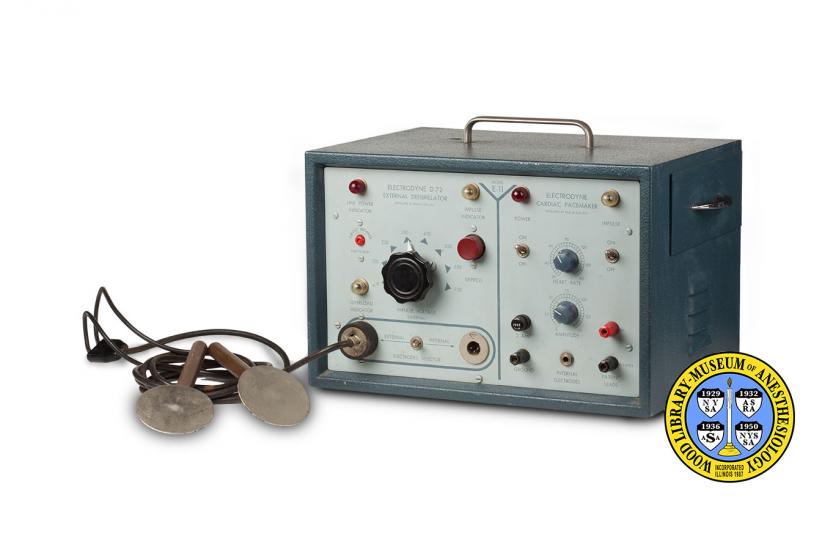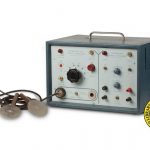Electrodyne Defibrillator-Pacemaker
Anesthesiologists are responsible for maintaining the patient's vital functions during surgery. This includes monitoring the heart, and performing cardiac resuscitation when necessary. Blood circulates through the body, moving from the heart and back again, because electrical impulses cause the heart to contract and relax. When these impulses are disturbed, the heart may lose its rhythm, or stop. In the 1950s, the American cardiologist, Dr. Paul M. Zoll (1911-1999) pioneered electrical cardiac resuscitation and cardiac monitoring devices.
Together with engineer Alan Belgard, Dr. Zoll designed this early dual-function apparatus, made by the Electrodyne Company, of Norwood, Massachusetts. Electrodyne built the first external pacemaker in 1952, and went on to make many other portable machines based on the technologies developed by Dr. Zoll. The model E-11 was made from the late 1950s through the 1960s. It combines a defibrillator, to restore the heart’s beat, and a pacemaker, to maintain a regular heart rhythm.
Catalog Record: Electrodyne Defibrillator-Pacemaker
Access Key: akwi
Accession No.: 2008-08-14-2 D
Title: Model E-11 : Electrodyne D-72 external defibrillator [and] Electrodyne cardiac pacemaker.
Corporate Author: Electrodyne.
Title variation: Alt Title
Title: Defibrillator-pacemaker.
Title variation: Alt Title
Title: Electrodyne E-11 : combination external defibrillator-pacemaker.
Title variation: Alt Title
Title: Electrodyne E-11 : combination external cardiac pacemaker and external
defibrillator.
Publisher: Norwood, Mass. : Electrodyne, [between 1956 and 1965].
Physical Descript: 1 defibrillator and pacemaker : metals, plastics ; 29.5 x 45 x 35 cm.
Subject: Defibrillators.
Subject: Pacemaker, Artificial – instrumentation.
Subject: Cardiopulmonary Resuscitation – instrumentation.
Subject: Heart Arrest – therapy.
Note Type: General
Notes: The early year in the date range for the possible year of manufacture is an
estimate based on the earliest dated documents in which the Model E 11 is
found to be mentioned (1957). The end date is an estimate based on the
introduction of safer direct current external defibrillation in 1962
(Akselrod, Kroll & Orlov, 2009). Also, the latest dated advertisement found
for the Model E-11 was in a 1962 or 1963 issue of the Medical Bulletin (this
was seen in a Google Books snippet view only). The date range could change if
documentation indicates that it should be corrected.
Note Type: General
Notes: Akselrod H, Kroll MW, Orlov MV. History of defibrillation. In: Efimov IR,
Kroll MW, Tchou P, eds. Cardiac Bioelectric Therapy: Mechanisms and Practical
Implications. Boston: Springer; 2009:15-38.
Note Type: General
Notes: Cohen SI. Paul M. Zoll, —The father of “modern” electrotharapy and innovator
of pharmacotherapy for life-threatening cardiac arrhythmias. Resuscitation.
2007;73(2):178-185.
Note Type: General
Notes: Eisenberg MS. Defibrillation is the spark of life. In: Life in the Balance:
Emergency Medicine and the Quest to Reverse Sudden Death. New York: Oxford
University Press; 1977:192-195.
Note Type: General
Notes: The story of cardiac arrest [aflyer with accompanying marketing letter].
Norwood, Massachusetts: Electrodyne Co., Inc.; 1957. [The flyer includes
images and descriptions of five Electrodyne products, including the
“Electrodyne D-72 — for EXTERNALLY APPLIED treatment of ventricular
fibrillation”. The letter is dated February 18, 1957, addressed to, “Dear
Doctor,” and signed by Normal H. Simon, Sales Manager.]
Note Type: Citation
Notes: Zoll R. 50th anniversary of defibrillation: Paul M. Zoll, MD and the
beginning of Zoll Medical Corporation. EP Lab Digest. July, 2006;6(7).
https://www.eplabdigest.
com/articles/50th-Anniversary-Defibrillation-Paul-M-Zoll-MD-and-Beginning-ZOL
-Medical-Corporation. Accessed September 5, 2014.
Note Type: Physical Description
Notes: One defibrillator and pacemaker that measures approximately 29.5 x 45 x 35
cm; The sides, top and back are painted dark blue and the face is light blue
with dark blue markings; On the left side of the front of the device are
controls for the defibrillator function and on the right are controls for the
pacemaker function; A fluted knob on the left side, marked, “IMPULSE VOLTAGE
[new line] (EXTERNAL)”, can be set to one of eight points that are marked by
small triangles and numbered, 0, 15, 250, 350, 450, 550, 650, 750; Below the
knob is a switch that can be moved to the left or right; To the left of the
switch is a twist plug for the external defibrillator paddles; To the right
of the switch is a plug for internal defibrillation electrodes; The external
defibrillator paddles and cord measure approximately 368 cm in length; The
paddles alone measure approximately 26.5 cm in length with the contacts
having a diameter of approximately 8.5 cm; On the right side of the face of
the device, where the pacemaker functions are, there is an on/off switch for
power, an on/off switch for “IMPULSE”, a dial for heart rate, and a dial for
amplitude; The circular scale for heart rate is marked in increments of 3
from 30 to 60, and then in increments of 6 from 60 to 180; Increments at 30,
45, 60,90, 120, 150, and 180 are numbered; The scale for the amplitude dial
is marked in increments of 5 from 0 to 150, and numbered at 0, 25, 50, 75,
100, 125, and 150; Also on the left side are plugs for “INTERNAL ELECTRODES”,
“PATIENT LEADS”, and “GROUND”; An electrical cord extends from the back of
the device; The cord measures approximately 353 cm in length; There is a
handle on top of the device and a drawer with a handle on the right side; A
metal plate with manufacturer markings is fixed to the back of the device in
the right lower corner; Text on the plate includes, “SPECIALISTS IN [new
line] ELECTRODYNE [new line] MEDICAL ELECTRONICS [new line] NORWOOD, MASS. U.
S.A. [new line] MODEL E 11 SER. NO. 2236 [new line] VOLTS 105-120 AMPS
[BLANK] FREQ. 60”.
Note Type: Reproduction
Notes: Photographed by Mr. Steve Donisch, September 17, 2013.
Note Type: Historical
Notes: Described here is an early, dual function defibrillator-pacemaker designed by
American cardiologist Paul M. Zoll, MD (1911-1999) and engineer Alan Belgard.
It was made by Electrodyne, the company that built the first “external”
pacemaker in 1952.
“External” means that it worked via electrodes placed on the outside of the
chest as opposed to directly on the heart or “internally.” Electrodyne also
produced the first external defibrillator confirmed to interrupt a
life-threatening arrhythmia and return the heart beat to normal.
Defibrillators are used in emergencies to administer high-energy electrical
shocks to the heart for acutely life-threatening arrhythmias. Arrhythmias are
problems with the electrical system of the heart. There are many types, and
they can cause the heart to beat irregularly, too slowly, or too quickly.
This interferes with the heart’s ability to pump blood to the body. The most
critical arrhythmias prevent the heart from pumping blood at all. Shocks from
a defibrillator can interrupt these deadly arrhythmias and prompt the return
of a normal heart beat.
The heart’s electrical system includes a bundle of nerves and muscle that
‘pace,’ or regulate and control, the heart beat. An artificial pacemaker
delivers repeating electrical impulses when the heart’s natural ‘pacemaker’
is not working as it should. Pacemakers may also be used in the treatment of
some arrhythmias to override, regulate and coordinate the heart’s electrical
system.
When Zoll and Belgard developed their external defibrillator, the larger
medical community believed that external defibrillation was not possible
without great harm to the patient. Their success at demonstrating otherwise
caused a major shift in the development the defibrillators that came after.
From 1953 to the early 1960s many anesthesiologists used Electrodyne
defibrillators and pacemakers while caring for unstable and critically ill
patients. Dr. Zoll’s son, Ross Zoll, MD, became an anesthesiologist and
helped his father develop a safer and more comfortable external pacemaker
that was introduced in 1984.
Note Type: Exhibition
Notes: Selected for the WLM website.


